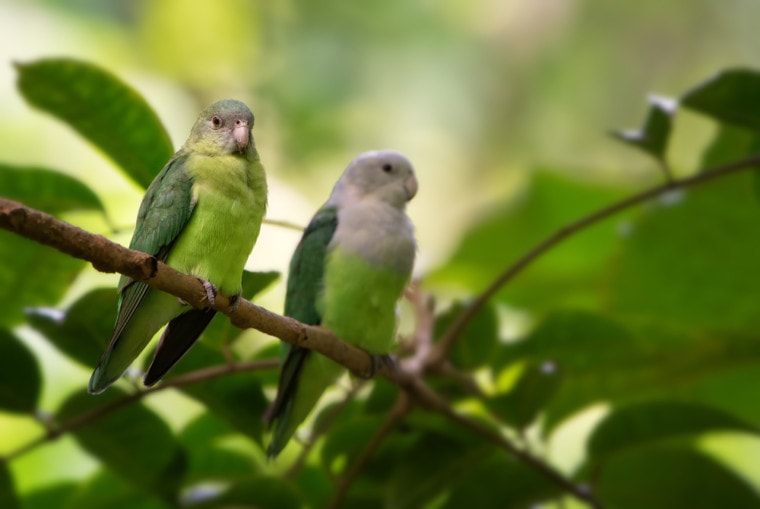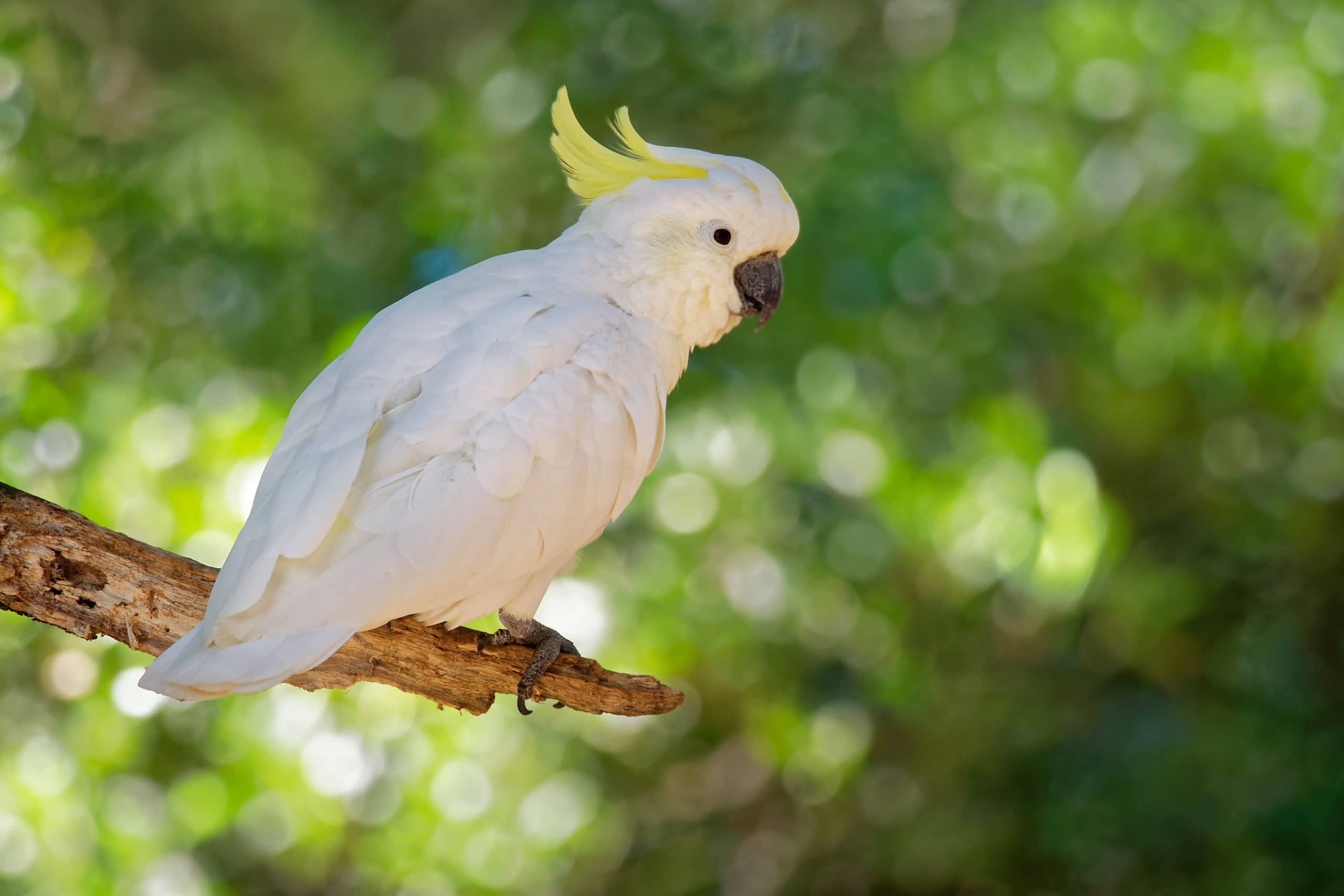
Click to Skip Ahead
Lovebirds are appropriately named for this species that mate for life. Nine types of birds exist in the genus Agapornis, but the Grey-headed lovebird is unique in that it’s native to Madagascar. Despite their small size, they have big voices but aren’t known to talk like parrots. Nevertheless, they make delightful pets if you’re lucky enough to find one.
Species Overview
| Color: | Dark green wings and back with a lighter green chest and grey head |
| Size: | 5 – 6 inches |
| Weight: | 30 – 36 grams |
| Life Expectancy: | 9 years |
If there is one thing that stands out about this bird, it’s the unique coloring. Males and females are similar in that they have a darker green color on their backs and wings. However, there is a lighter, more vibrant green on their chest, while the head is almost completely grey. The contrast is stunning, so it’s no wonder why some people want to keep them as pets.
Grey-Headed Lovebird Characteristics
History and Natural Habitat
As we mentioned, Madagascar is the home of the Grey-headed lovebird. German naturalist Johann Friedrich Gmelin gave the species its scientific name in 1788.1 You can’t deny how cute this bird is. It’s no wonder that it would be a hit as a pet. People brought this bird, like many others first documented at the time, to Europe. For decades, individuals caught wild specimens to take home.
Trade continued for decades. The International Union for Conservation of Nature and Natural Resources (IUCN) lists it as a species of least concern.2 However, the site also reported 107,829 wild-caught individuals in international trade. Still, an annual quota of 3,500 live birds is in place to protect the native population.4 It remains stable in its native Madagascar.
The Grey-headed lovebird has been introduced to the African island country of Comoros and the French Overseas Department of Mayotte.5 While there are no suspensions of trade, that can change if the wild population declines, warranting a review.

Things to Know When Owning a Grey-Headed Lovebird
Temperament
Lovebirds are the proverbial double-edged sword. They’re small and relatively easy to care for and raise. However, they require frequent handling and interaction to ensure they remain good pets. The Grey-headed lovebird is no exception. This bird can be flighty, particularly if you have a wild-caught specimen. However, even hand-raised pets may be challenging to handle.
Because of these traits, the Grey-headed lovebird isn’t as easy to breed in captivity as other species. Nevertheless, these birds form small flocks in the wild and would thrive best in a large enclosure with more than one pet. They aren’t as active as some species. They spend their days chattering among themselves. These lovebirds can become aggressive if not handled frequently.
Sounds, Speech & Vocalizations
Lovebirds aren’t known as talking birds like their parrot cousins. The occasional pet may pick up a word or two. They are more likely to mimic household sounds, not unlike cockatiels. They usually chatter and squawk quietly. However, they can make loud, shrill calls if startled. They may not be as loud as parrots, but they’re just as piercing.
Grey-Headed Lovebird Appearance
Scientists have documented two subspecies of the Grey-headed lovebird. They are separated geographically and have developed slight color variations through the generations. It’s worth mentioning that research suggests they have been introduced to other areas, which can also account for the differences.

Caring for the Grey-Headed Lovebird
The Grey-headed lovebird needs room to fly in a flight cage at least 4 feet long. It’s a social bird that prefers the company of its cohorts. It is also sensitive to the cold and drafts. Keep it in mind when deciding where to place your pet’s cage. This species is diurnal and usually begins and ends its day with chirps and shrills.
Diet and Nutrition
The Grey-headed lovebird eats various seeds, fruits, and nuts in the wild. It can be a nuisance in rice fields. You should bring that same kind of diverse diet to captivity. You can offer your pet small seed mixtures that contain millet and other favorites. Your lovebird will take other foods, such as fresh fruits like apples and leafy greens. Spray millet is another excellent choice.
Vitamin D deficiencies can be addressed with a UVB light or exposure to direct sunlight. You can also use supplements. However, a risk of toxicity also exists. Besides, your lovebird would probably enjoy the daylight more. Make sure fresh water is always available.
Exercise and Housing
The Grey-headed lovebird is quite agile and will readily explore its cage. That makes enrichment vital for its well-being. The cage should have horizontal wires to make it easier for your pet to climb. The spacing should be half an inch. You should also provide a water bowl for occasional baths to keep your lovebird occupied with something new to do.

Health & Conditions
A well-placed cage and a healthy diet can prevent many conditions that could affect your lovebird’s quality of life. The main concern with captive and wild birds is avian polyomavirus. Poor sanitation and contact with affected birds are the primary risk factors. Sadly, the infection is untreatable and often ushers in secondary health issues and complications.
Self-mutilation is another problem with birds that lack the necessary enrichment for mental stimulation. A bored pet will pluck its feathers, leaving bald patches. Therefore, it’s imperative to give these avid chewers plenty of things to do. Branches and wooden toys will satisfy these needs.
3 Little-Known Facts About Grey-Headed Lovebirds
1. Finding a Grey-headed lovebird for adoption or for sale is challenging.
Captive breeding is difficult. We suggest starting your search with your local animal shelter and avian veterinarian. You can also reach out to the African Love Bird Society, which focuses on this genus. If possible, restrict your search to hand-raised birds.
2. They are one of the smallest parrot species.
Weighing only about 30 grams and reaching up to 5 inches long, this lovebird is one of the smallest parrots in the world.
3. They are the only lovebird in its genus in Madagascar, while the others are native to Africa.
While there are nine species present in their genus, these lovebirds are endemic to Madagascar.
Conclusion
The Grey-headed lovebird is a cute and playful bird that will make a delightful pet. This species differs from others in its genus because of its rarity and jumpy disposition. We recommend keeping more than one bird together because of their social nature. You should also socialize your lovebird early, even if you’re not handling it often.
Featured Image Credit: David Havel, Shutterstock







